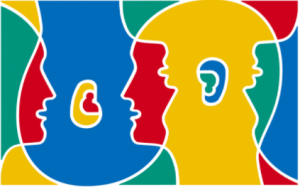 To most American English speakers, languages written in non-Romanized letters seem impossibly difficult. Their very unfamiliarity is off-putting at the least, and constitutes a deal-breaker for many. “How can I possibly learn….? (Fill in the blank: Hebrew, Mandarin, Arabic, Russian, etc.) The writing is downright indecipherable!”
To most American English speakers, languages written in non-Romanized letters seem impossibly difficult. Their very unfamiliarity is off-putting at the least, and constitutes a deal-breaker for many. “How can I possibly learn….? (Fill in the blank: Hebrew, Mandarin, Arabic, Russian, etc.) The writing is downright indecipherable!”
After 4 sessions (around +-2 hours total) of high-frequency-verb-containing Hebrew Comprehensible (auditory) Input, I decided it was time to shift gears for a moment and have our kids try their hand at Hebrew writing. I also wanted to dispel any fear of ‘cursive without vowels’ for my students and their parents before it surfaced. Not that they haven’t written Hebrew before….All but this year’s 3rd graders have explored the Hebrew written word to various degrees. The younger grades (3rd – 5th) have mostly decoded liturgical Hebrew and have muddled through Modern Hebrew basal readers that slice and dice the language into isolated letters, phonemes and chunks in an effort to lay-in letter-sound correspondence (plus nikkud = vowels). This laser focus on discreet sounds has been all but abandoned in most Language Arts classrooms, in favor of reading instruction centered on whole words and phrases, the building blocks of meaning. The 6th graders explored trope last year as they prepared for their Bar and Bat Mitzvah, and have happily retained their solid decoding skills.
Since September 7, my 3rd through 7th graders have seen me establish meaning by writing words on the board in Hebrew, and translating them to English right below, regularly pausing and pointing to reinforce & connect the written word with sound with meaning. Now it was time to scaffold another language experience where they’d feel successful and encouraged. It called for a fail-proof process, so I employed my secret ace-in-the hole tool: The humble and hardworking dry erase lap board.
Any multi-step procedure in the CI classroom is but a (cloaked) opportunity/invitation for careful listening and repetitions, so I turned the distribution and handling of the materials into Total Physical Response (TPR):
(בעברית)
Put your board, pen and eraser under your chair.

Pick up your board.
Put your board under the chair.
Pick up the pen. Open (un-cap) the pen. Close the pen.
Put the pen under your chair.
Pick up the eraser. Put the eraser under your chair.
Pick up the board.
I gestured and paused/pointed to all necessary vocabulary written on the big board. So far so good.
Next I had the kids take off their name tags and place it on their lapboards, on the lined side (the flip side is un-lined). I asked them to copy their Hebrew names with their pointer finger between the lines on the board. I referred to this simple print and cursive Alef Bet poster I’d hung on the wall, reminding them that we’d be using cursive exclusively. Finger spelling IS NOT BABYISH when you’re learning (reviewing?) to form new letters!
I invited my kids to uncap their markers and, with no regard for letter formation, copy their Hebrew names onto their dry-erase lapboards. Again and again. I circulated around the room with the other Hebrew teachers, insuring that the sofIT letters were long/tall enough, that the ’ר’ didn׳t look like a ’כ’ and so on.
It never fails. Students love to skate and glide their markers across the shiny board surface. And the task is so forgiving. If you make a ’ד’ that looks like a ’צ’, then simply sweep it away with your eraser and try, try again. Mistakes are good. They mean you’re trying. Confident students were encouraged to write their names without looking at their name tag exemplar.
Soon I was looking at a sea of proud faces and Hebrew-filled lapboards.
Next I modeled these instructions (I used some English here):
Erase your boards.
 Stand up.
Stand up.
Raise one arm.
Close your eyes.
See your Hebrew name in your mind.
Copy your name in the sky. (That’s right. 3rd through 7th graders skywriting.)
Sit down.
It was nearly time to go. I asked who wanted to try a bit more writing – this time a complete sentence. Hands shot up like weeds after a summer storm.
I urged them to write the word, ’אני’ followed by their Hebrew name, as in, ’אני עליזה’. “I am Alisa.” A notebook exercise blossomed into a meaningful message before our eyes.
Their faces lit up with success.
“Is Hebrew writing as hard as you thought it would be?” “Not really.”
Not when you have what you need. Not when your message is simple and narrow.
Before class ended, I assigned the first ‘major’ homework assignment of the year:
To skywrite their Hebrew name as often as possible over the next few days – in the shower, in bed, in the car…. And for extra credit? To extend to a sentence by putting ‘אני‘ in front of it. .אני שמחה

 For nearly 25 minutes we spent time in Hebrew trying to track down felafel for our hungry protagonist. First she went to Maggiano’s, our Italian venue, hungrily seeking felafel. I accompanied her across the classroom toward the Maggiano’s poster, where a Maggiano’s representative/classmate was waiting, a luscious slice of (plastic) pizza in one fist, a rubbery beige disc of coiled pasta in the other. I did the talking while my actors silently brought our drama to life. As dramatic director, I coached Leah to rub her stomach, stating that she loves felafel, while the class confirmed that no, unfortunately Maggiano’s doesn’t have felafel. It has pizza, and it has spaghetti.
For nearly 25 minutes we spent time in Hebrew trying to track down felafel for our hungry protagonist. First she went to Maggiano’s, our Italian venue, hungrily seeking felafel. I accompanied her across the classroom toward the Maggiano’s poster, where a Maggiano’s representative/classmate was waiting, a luscious slice of (plastic) pizza in one fist, a rubbery beige disc of coiled pasta in the other. I did the talking while my actors silently brought our drama to life. As dramatic director, I coached Leah to rub her stomach, stating that she loves felafel, while the class confirmed that no, unfortunately Maggiano’s doesn’t have felafel. It has pizza, and it has spaghetti.
 I wanted our kids to walk away feeling encouraged. And successful. And smiling. Those were my ‘curricular goals’ from which I decided to backwards-plan. No worries about hi-frequency structures, circling, repetitions, or the like… yet. Just a fun, informal meeting & intro with some back-and-forth Hebrew communication.
I wanted our kids to walk away feeling encouraged. And successful. And smiling. Those were my ‘curricular goals’ from which I decided to backwards-plan. No worries about hi-frequency structures, circling, repetitions, or the like… yet. Just a fun, informal meeting & intro with some back-and-forth Hebrew communication.
 miliar routines (i.e., greeting/goodbye song) which provide much needed structure for the wee ones. But alas, my classroom is sweaty (no air conditioning); the chairs are hard (transitioning from the rug and plenty of stretching and movement can only help so much!) and the kids are tired, hungry, need a Band-Aid, want a drink, have a tummy ache, just lost a tooth…in short, they find it hard to stay focused. This will change as they grow accustomed to the new school year and schedule, but it means that I can’t expect or push too much…yet. Limited language input, no full-on circling, lots of movement (we did some modified yoga poses) and plenty of props. We picked our favorite (plastic) snacks and using “want” and “looks for,” we pretended to eat them.
miliar routines (i.e., greeting/goodbye song) which provide much needed structure for the wee ones. But alas, my classroom is sweaty (no air conditioning); the chairs are hard (transitioning from the rug and plenty of stretching and movement can only help so much!) and the kids are tired, hungry, need a Band-Aid, want a drink, have a tummy ache, just lost a tooth…in short, they find it hard to stay focused. This will change as they grow accustomed to the new school year and schedule, but it means that I can’t expect or push too much…yet. Limited language input, no full-on circling, lots of movement (we did some modified yoga poses) and plenty of props. We picked our favorite (plastic) snacks and using “want” and “looks for,” we pretended to eat them.